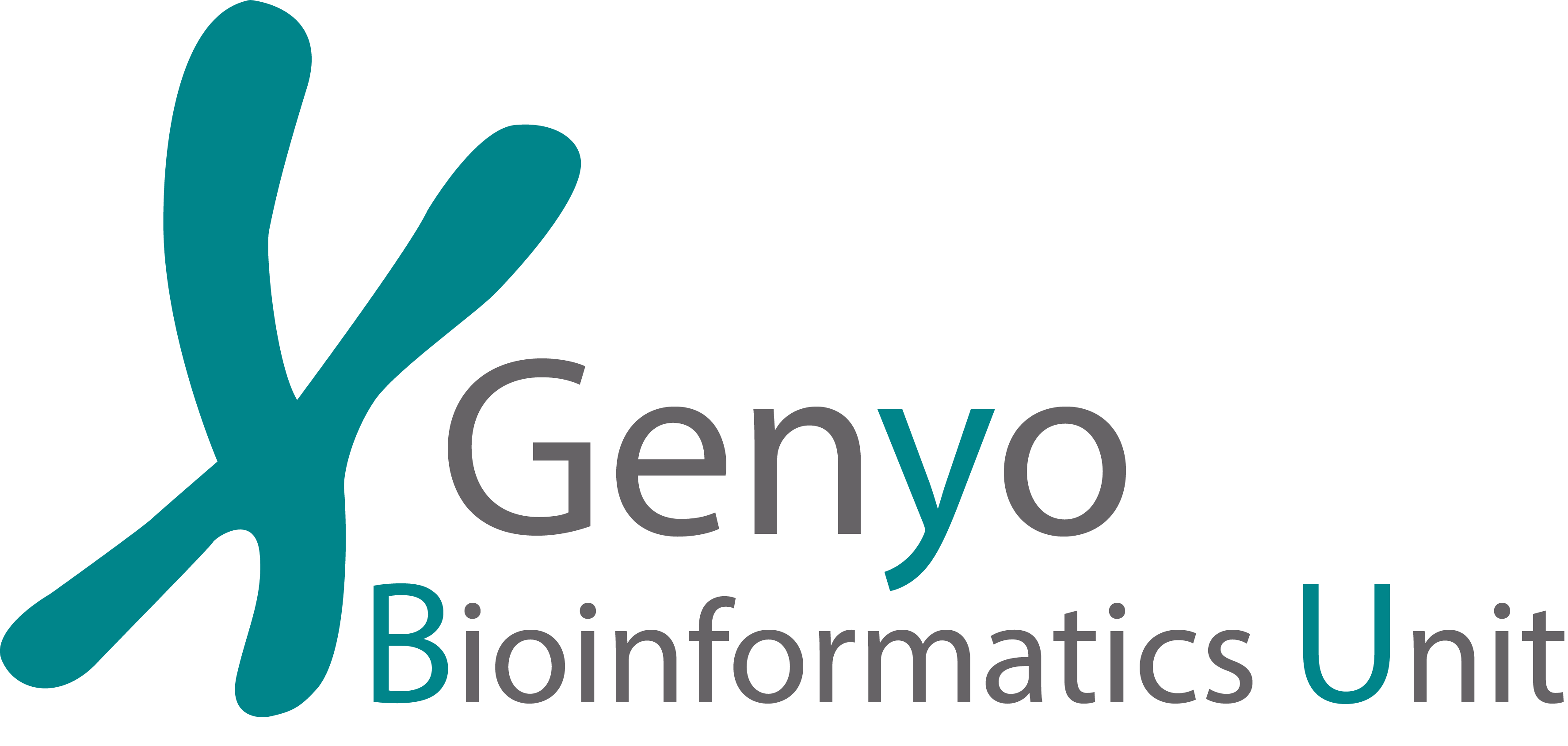Variable 1 (circles)
Variable 2 (colours)
DatAC is a collaborative project conducted by a multidisciplinary group of researchers.
Team
Pedro Carmona-SáezProject coordinator
Department of Statistics, University of Granada and Bioinformatics Unit, GENYO
Contact: pedro.carmona@genyo.es
Jordi Martorell-MarugánMain application developer
Bioinformatics Unit, GENYO
Juan Antonio Villatoro-García
Data collection and analysis
Bioinformatics Unit, GENYO
Adrián García-Moreno
Application codeveloper
Bioinformatics Unit, GENYO
Raúl López-Domínguez
Application codeveloper
Bioinformatics Unit, GENYO
Collaborators
- Francisco Requena, Imagine Institute of Genetic Diseases
- Juan Julián Merelo, Department of Computer Architecture and Technology, University of Granada
- Marina Lacasaña, Andalusian School of Public Health
- Juan de Dios Luna, Department of Statistics, University of Granada
- Juan José Díaz-Mochón, Centre for Genomics and Oncological Research (GENYO)
- José Antonio Lorente, Centre for Genomics and Oncological Research (GENYO)
Map
Here you can explore all the data, representing two variables at the map as circles and background colors. Variables are selected at the left panel, as well as the date to take into account for each one. A table with the data for the selected variables is also available at this left panel. You can select a region to explore their historical data. By default, you can select autonomous communities. However, if you zomm in the map, provinces can be selected. The plots are generated at the right panel for the dates selected at the top of this panel. If you only select one variable, an interactive barplot will be generated. If you select two variables, a line with the second variable will be drawn over the bars. In addition, a correlation plot will be drawn with a regression line.
Trend analysis
In this tab, the relationship between two variables can be analysed. At the left panel, variables can be selected, as well as the dates to take into account and the model. The implemented models are polynomial model, correlation and loess regression. For polynomial model, the grade can be selected (from 1 to 6). For correlation, the method can be chasen as well. In addition, correlation can be corrected by lockdown days. To do this, a partial correlation is calculated controlling for the number of days since lockdown was declared in Spain (March 14th, 2020). A lag can be applied to the second variable. For instance, if 2020-01-01 to 2020-01-31 perdiod with a 10 days lag are selected, variable 1 will contain the data for these dates, but variable 2 will contain the data for 2020-01-11 to 2020-02-10 period. Negative lag can be also applied. This is a way to find correlations between two variables with some time difference. The analysis results appear at the right panel, with the model, R2 and P-value for polynomial models and correlation value and P-value for correlation. Loess regression does not return any results, given than it is difficult to translate this regression to a mathematical equation. Notice that, sometimes, it is not possible to fit a high-degree polynomial model if there is not enough data. An error message will appear if this happens.
Time trends
Here, the variables tendencies along time can be explored for one or two variables in one or serveral regions. Variables, lag, dates and regions can be selected at the left panel. An interactive multiline plot is generated. Take into account that, if several regions are selected, it may be difficult to differenciate their lines at the plot. In addition, a scatter plot with the data for all the selected regions es generated.
Variables information
Sources links
- MISAN (Ministry of Health of Spain)
- Datadista
- Escovid19data
- IECA (Andalusian Institute of Statistics and Cartography)
- EEA (European Environment Agency)
- CAGPDS (Andalusian Office of Agriculture, Livestock, Fisheries and Sustainable Development)
- AEMET (Spanish meteorological agency)
- INE (Institute of Statistics of Spain)
* There may be some differences in data from communities and provinces due to these are provided from different sources.
Versions
- 1.7 (2021-07-28): Rt variable added.
- 1.6 (2021-01-29): Vaccinations data added.
- 1.5 (2020-11-18): Punctual ICU, Daily discharged, Hospitals occupancy and ICU occupancy variables added.
- 1.4 (2020-09-18): Seroprevalence and punctual hospitalizations data added.
- 1.3 (2020-09-01): Mobility data added.
- 1.2 (2020-08-20): GAM models added in Trend Analysis tab.
- 1.1 (2020-07-09): Partial correlation option added in correlation analysis for correcting for days of lockdown.
- 1.0 (2020-06-08): First version.
Citation
If you use DatAC, please cite the following article:
Martorell-Marugán J, Villatoro-García JA, et al. DatAC: A visual analytics platform to explore climate and air quality indicators associated with the COVID-19 pandemic in Spain. Science of The Total Environment, 2020, 141424. https://doi.org/10.1016/j.scitotenv.2020.141424
Contact
If you have any questions or suggestions, you cant contact us at bioinfo@genyo.es.

DatAC web-server was developed and is maintained at the Bioinformatics Unit - GENYO
Code is available at GitHub
Article is published at Science of the Total Environment journal
Supported by FEDER/Junta de Andalucía-Consejería de Transformación Económica, Industria, Conocimiento y Universidades

Last update: 2022-10-18
DatAC is intended only for scientific research, so it should not be used for taking any medical or governance decision. We are not responsable for the data shown or any conclusions that could be derived from the data.



